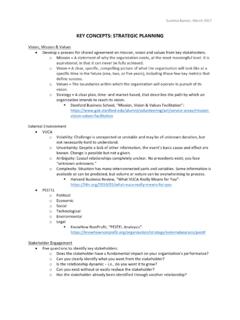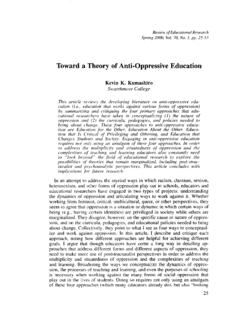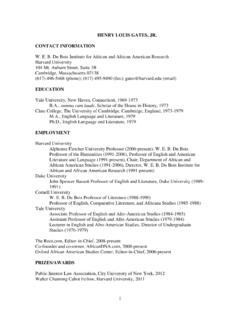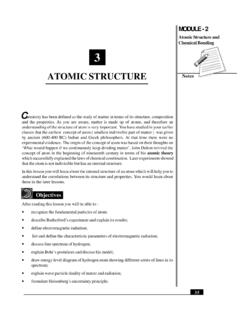Transcription of Atomic Structure & Chemical Bonding - Harvard University
1 Atomic Structure & Chemical Bonding1 What is life? Why is an elephant alive but a table inert? Why are cells alive but their contents when transferred to a flask inanimate? The answers to questions about the nature of life lie in the chemistry of the atoms and molecules that make up living things. Life is an emergent property of the Structure and reactivity of atoms and their capacity to make and break bonds with each other. Understanding the basis for life is inseparable from understanding the principles that govern the behavior of atoms and molecules.
2 In the chapters that follow, we will focus on the concepts of chemistry that are necessary for understanding life and apply these concepts to understanding how living things work. We begin with an explanation of why and how atoms bond together to form is based on Chemical interactionsLet us start with an example of why understanding the properties of atoms and molecules is essential for understanding living systems. Figure 1A shows a protein, depicted in green, attached to a DNA molecule, shown in orange. The association between this specific protein, called p53, and DNA is essential for maintaining the integrity of the human genome.
3 Without this interaction, cells mutate rapidly and cancer develops. In fact, p53 is so important that its malfunction is implicated in about half of all human cancers. To understand how p53 is able to interact with DNA, it is important to recognize that both proteins and DNA are composed of many thousands of atoms (shown as connected by lines in Figure 1A). These large molecules, interpret the properties of elements that are important for life from the periodic table. understand why and how atoms form bonds. draw Lewis dot and line structures to represent Chemical this chapter , you should be able toTo understand why atoms form Structure & Chemical BondingChapter 12or macromolecules, interact with one another because particular atoms in one molecule are attracted to particular atoms in the other molecule.
4 Figure 1B highlights a few of the key attractions that exist between atoms in p53 and DNA (shown as black dotted lines). The alteration of just one or two specific atoms would dramatically reduce the ability of p53 to bind to DNA. We will examine the nature of these interactions later, but for now it is important to appreciate that the identities and Chemical properties of just a handful of atoms within a molecule consisting of thousands of atoms can be critical for the functioning of living systems. As you will see, many properties associated with life emerge from the structures of molecules and the ways in which they interact with one another.
5 To understand how molecules interact, we first need to learn more about the atoms and bonds of which they are composed. In chapter 2, we will examine the attractive forces that cause atoms in different molecules to interact with one DNADNA protein (A)(B)Figure 1 Fundamental properties of living systems emerge from Atomic -level structural and Chemical features(A) A protein (green) interacts with DNA (orange). (B) The interaction is mediated by attractive forces between specific atoms in the protein and specific atoms in the DNA, as indicated with black dotted lines. ProteinDNAH3 NNH3 OOOOPOOOHONNNNNH2 Amino acidNucleotideFigure 2 Many important molecules of life are macromoleculesShown are the three-dimensional structures of two macromolecules, a protein and DNA.
6 A representative monomer subunit for each macromolecule is shown to the Structure & Chemical BondingChapter 13 Cells consist of macromolecules and small moleculesProteins and DNA are polymers of amino acids and nucleotides, respectively (Figure 2). These and other kinds of macromolecules carry out the biological processes that make life possible. For example, some macromolecules store genetic information that is passed down to future generations. Some are involved in decoding genetic information. Yet other macromolecules carry out metabolism, breaking down molecules to obtain energy and using that energy to build other molecules.
7 In addition to macromolecules, small molecules play a central role in living systems. Although there is no discrete size cut-off that distinguishes small molecules from macromolecules, most small molecules that are relevant to life contain fewer than about a hundred atoms. Unlike macromolecules, which are polymers of repeating units, small molecules are diverse in their structures and typically lack repeating units. Their diversity implies that small molecules are synthesized in the cell by a more diverse collection of Chemical reactions than those used to make macromolecules.
8 Indeed, as we will learn later, macromolecules are typically generated by repeating one type of Chemical reaction over and over, while small molecules are synthesized through the use of thousands of different reactions. Figure 3 shows examples of small molecules that occupy center stage in the story of life. Here, we are concerned with the Chemical rules that govern how the atoms in these molecules interact with each is important to remember that in a cell these macromolecules and small molecules are bathed in water along with an enormous number of ions (salts).
9 As we shall see, water affects the way that all other molecules in the cell function; indeed, life itself could not exist without an aqueous periodic table arranges atoms according to numbers of protons, numbers of electron shells, and valence electronsMolecules are composed of atoms, which are the units of matter that correspond to the elements in the periodic table of elements (Figure 4). Only a few elements are abundant in cells. In fact, the vast majority of Figure 3 Myriad small molecules are important for lifeShown are examples that illustrate the diverse roles that small molecules play in living systems.
10 Glucose is a sugar that is used as an energy source; cholesterol is a component of animal cell membranes; pyridoxine is a vitamin (B6); and serotonin is a Structure & Chemical BondingChapter 14biological matter, about 99%, is made of just six elements: carbon, hydrogen, nitrogen, oxygen, sulfur, and phosphorus. Most biological molecules, such as proteins, carbohydrates, lipids, and nucleic acids, are exclusively composed of these elements. A few other atoms also play roles in biology; these include calcium, chlorine, iron, magnesium, potassium, sodium, and zinc.

















